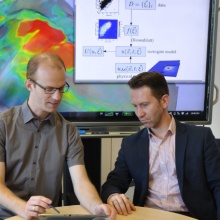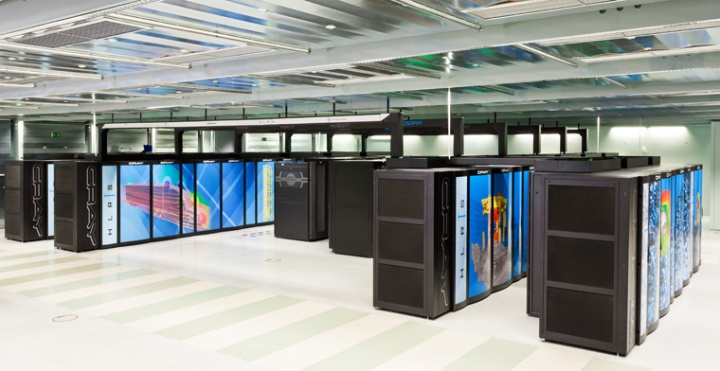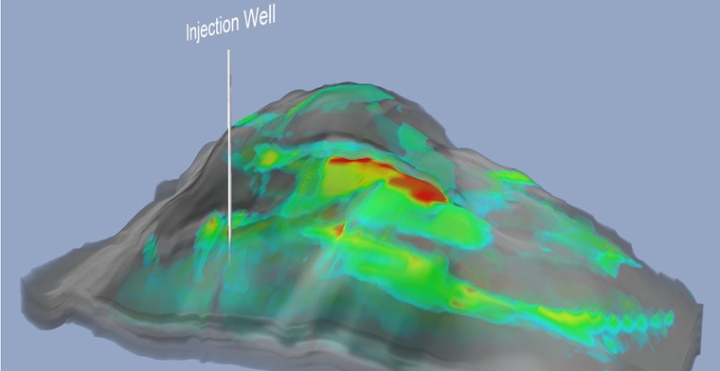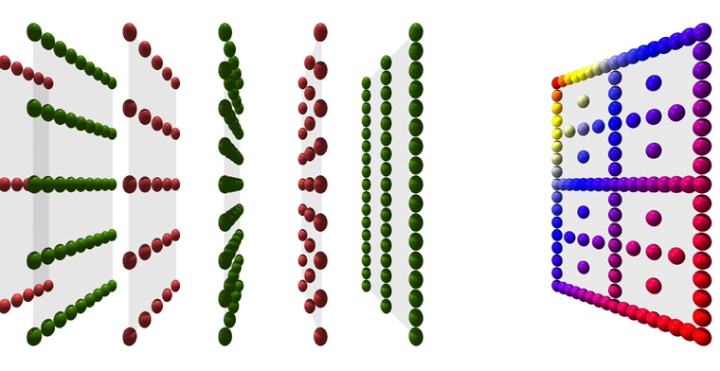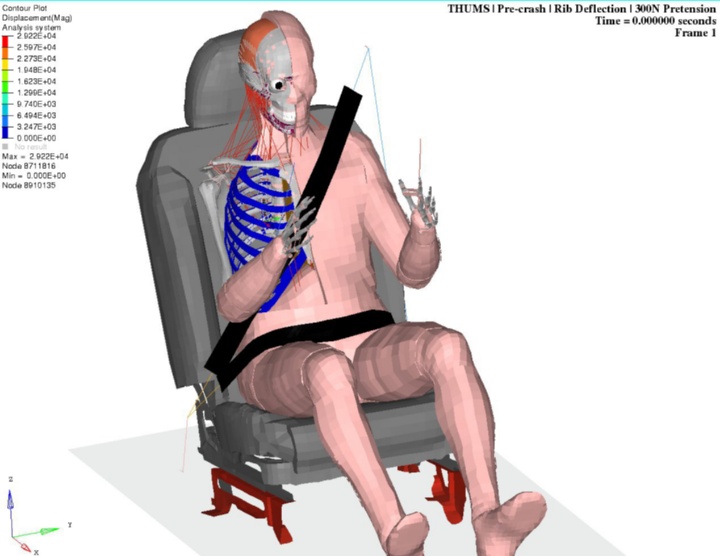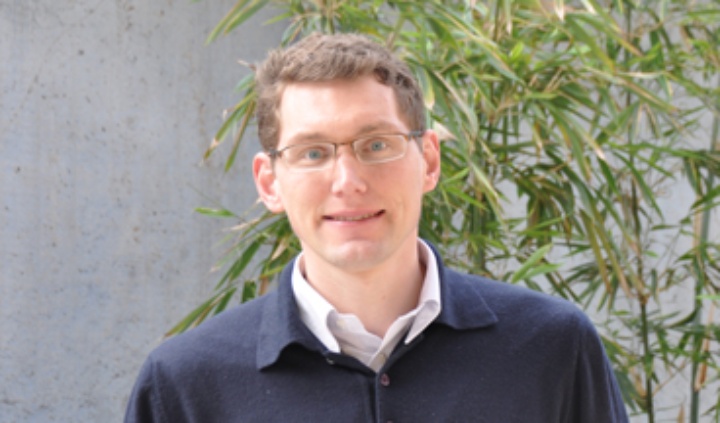It’s a complicated world, that much is certain. One great aim of science is not only to understand it but also to get behind the interrelationships - in fact, to make them predictable. The challenge is: the incalculable. In this regard, a third avenue to understanding has opened up in the last few decades as a support for experimentation and theory: simulation.
The Stuttgart Research Centre for simulation Technology (SRC) networks next-generation scientists from quite unrelated disciplines at the University of Stuttgart and the SimTech Excellence Cluster. The goal: to support gifted young scientists with a broad-based offering of courses and seminars, intensive mentoring, research and study abroad, and interdisciplinary stimulation of ideas.
Just to give an example: SimTech provides interesting perspectives that include a graduate school with about 150 doctoral candidates from nine of the University of Stuttgart’s ten faculties, an elite course of studies leading to Bachelor’s and Master’s degrees, postdoc positions, and junior professorships. The simulation models developed here with state-ofthe- art technology and the know-how of far more than 100 researchers aim to develop answers to complex issues and scientific questions.
Simulations have one purpose above all: to reduce the number of incalculables. Not only do they reproduce processes, they also predict them. This scientific technique for peering into the future has established itself today in all areas of life: from financial crises to environmental catastrophes that we can see coming with the help of simulations before they occur. This sometimes involves supercomputers whose immense calculatory abilities can take the user virtually through global scenarios from the future. Many simulation tasks require such great calculation capacities that they challenge even the underlying software and models. Computer pioneer Seymour Cray summed the issue up this way: ‘If you’re going to plow a field, which would you prefer to use: two strong oxen, or 1024 chickens?’. We naturally tend to think that it’s easier to use one big, fast processor than many slow ones.
The fact is, however, that computers have sped up in the last 10 years or so not because individual processors have become faster, but because there are more of them: more than 180,000, for example, in ‘Hazel Hen’, Germany’s speediest computer in Stuttgart-Vaihingen. That makes it a challenge to use such computers. Just for comparison: if automobiles since 1970 had become faster at the same rate as computers, they would be traveling today at several times the speed of light. The result: today’s scientists in this field travel between virtual and real worlds to gain new, sometimes epochal insights into the forces that move the world and will continue to do so.
Safer CO2-storage
In climate protection, for example. Every year, we produce vast amounts of carbon dioxide - in Germany alone, some 793 million tons in the year 2014. This has made underground storage of carbon dioxide into an important point of attack in the battle against climate change, and two young researchers, Dr. Sergey Oladyshkin of the University of Stuttgart’s Institute for Modelling Hydraulic and Environmental systems (IWS) and Junior Professor Dirk Pflüger of the University’s Institute of Parallel and Distributed systems (IPVS), along with the latter’s doctoral can- didate Fabian Franzelin, are working on a simulated system of CO2 sequestration. Their goal: permanent storage of carbon dioxide in underground waste sites in order to reduce emissions into the atmosphere. On the other hand, some scientists question the true safety of this technique. Their reasoning: we have few data about events at a storage depth of approximately 1,000 meters below ground. This makes it uncertain, for example, just what the composition of the earth is at that depth. But it is precisely this knowledge which is essential in order to avoid the danger of stored CO2 emerging when under pressure.
This in turn requires that more precise geological information be procured, which in turn will require a few highly expensive drilling operations in order to procure samples. ‘Unfortunately, we do not have an X-ray machine that can make the entire planet transparent. That would, of course, make our simulation work much easier,’ is how Dirk Pflüger illustrates the challenge in dealing with incalculables when creating simulation models. ‘What we’re looking for is to turn ‘What don’t I know?’ into ‘At least I know what I don’t know,’ or better: ‘At least I know how much I don’t know’, adds Sergey Oladyshkin.
Interesting intersections
Dirk Pflüger is a specialist in informatics, Sergey Oladyshkin in applied mathematics; but even though their disciplines are different, their research has some interesting interfaces: Pflüger works out the research methods for working with a simulation created by Oladyshkin. The parameters to be considered in CO2 sequestration are manifold: where can CO2 be pumped into the ground, for example, in what quantities and under what pressure? Will CO2 leak uncontrollably out of drill holes or due to weak points in the rock layers? Conventional scientific methods quickly reach their limits when the attempt is made to take all these dimensions into account in a single model. The description used by scientists in this context is, ‘the curse of dimensionality’. But now computer simulations offer new ways of inputting existing data as fruitfully as possible.
To this end, Dirk Pflüger and his group are working out methods for the approximation of high-dimensional functions on the basis of ‘sparse grids’. He compares this principle to that of sinking warships: ‘The first thing is to sink the battleship with as little loss of time and effort as possible; then come the lesser ships, and then the smallest one.’ The same holds true for simulation: the first thing is to present the key interrelationships as quickly as possible and with as little time and effort as possible.
From basic research to application
The aim is to make the results more reliable on the basis of data-driven approaches and to make factual incalculables visible. Why is it important to quantify incalculables? That makes it possible to develop methods for reducing the complexity of computer-intensive simulation concerning CO2 sequestration, thus making it computable within an acceptable period of time. The development of better methods of computer simulation puts the researchers on the one hand in the field of basic research. But at the same time, their work remains application-oriented inasmuch as they are dealing with real data. The results are of interesting not only to them but also for international research institutions: For example, Dirk Pflüger is also collaborating with the Sandia National Laboratories in the U.S.A. to pursue and publish the results. ‘We are working above all on the question of how to master high-dimensional relations of dependency, not only with regard to the mathematics on which they are based but also regarding efficient implementation of all this and how to turn it into useful tools and software. What’s nice about this project is that we constantly move back and forth between basic research and its application,’ says Dirk Pflüger.
Making traffic safer
Yet another SimTech project is undergoing concrete application; it found in an area in which safety is per se preeminent: street traffic. Accident statistics have shown that far more than 90 percent of all automobile accidents stem from human failure. Passive driving safety systems - for example with safety belts and airbags - can cushion the consequences of accidents. But it’s even better, of course, if the accident doesn’t happen at all. The future therefore belongs to active forms of driving safety that nip accidents in the bud. Driver assistance systems warn the driver of risky situations and help him/her to react correctly. With their electronic brake assist functions, ABS and ESP and in some cases voice control and lane-change warning signals, these systems harbor an enormous potential for further development. After all: the time preceding the accident itself is in the range of seconds: precious seconds that can save lives - as simulations make clear.
‘Our vision is for ongoing measurements to take place within the auto itself and for calculations to be carried out at every moment in order to ensure the individual safety of the driver at moments of danger,’ is how Jörg Fehr, Junior Professor for Multibody Dynamics at Sim-Tech, outlines the overall aim. After becoming a simulation engineer for multiphysical crash simulations at TRW (now ZF TRW), he worked with a team on the development of new safety systems for automobiles, was one of the first graduates of the Simulation Technology Cluster of Excellence, and leaped at the chance in his third year of working in industry to come back to the academic world. Now, as a next-generation researcher, his current work lets him combine research questions from industry and science in order to improve the safety of vehicles. There is a manifold range of new approaches, like considerations involving the driver’s muscle activity, or longer simulation horizons, or the uncertainty of parameters which must be studied in order to better simulate human behavior during accidents.
A better understanding of the 'System Called Man'
Two aspects are relevant for this: on the one hand, the issue is to create a model of the human being and his/her behavior as well as possible and simulate it accordingly on a computer. This helps us to identify causes of injuries from traffic accidents more exactly and to precisely evaluate the effectiveness of various safety systems. Among other things, the research team here takes the approach of simulating muscle models. The reason: when accident is imminent, the driver changes position by means of muscle activation, and this affects the sequence of movements. The simulations here go far beyond experiments carried out with crash-test dummies, since the latter present only a mechanical approximation. In cooperation with the Institute of Sports Science (InSpo), an extensive series of trials and experiments were carried out, ideas were exchanged, and disciplines were combined in order to better understand the ‘System Called Man’. Another aim is to optimize the time for calculating crash simulations by means of model reduction techniques. That in turn involves correctly defining the complexity of the models in accordance with the task at hand.
Miliseconds make the difference
The question is: How can we reduce the order of the equation system while still retaining the system’s essential information? After all: the moment required for the accident itself to occur ranges between only 80 and 120 milliseconds, but the process as a whole has already begun some seconds before that, namely at the time when the active safety system is triggered. A simulation, however, must take the entire phase into account, with the result that the computer’s calculations need more time. ‘The speed is breathtaking; ten million equations must be solved 500,000 times throughout a single night in order to completely calculate a simulation of 120 milliseconds’ duration. But a look at the entire elapsed time required by active vehicle safety systems shows that it quickly takes ten times as long,’ explains Fehr. The solution is to make calculations faster by reducing the model to the most important factors, meaning that orders and dimensions must be made as small as possible, but as big. as necessary. The results make it possible to arrive at precise statements about whether the safety system in question is good or bad - and for whom. These results are directly related to the development of driving safety systems and help to make them even safer. ‘It’s very important to us not to do our research in a vacuum,’ says Fehr determinedly; ‘we want to create added value and work out solutions that have concrete applications.’
Simulation: the model of the future?
One thing’s for certain: the classical image of the researcher has gone the way of the dinosaurs. Today’s task descriptions are far too complex to be worked out hit-and-miss by lonely persons working behind closed doors. Today’s challenge is to perfect models in an ongoing, iterative process while also combining them in ever-new ways through interdisciplinary interactions. This has led to a broad interdisciplinary environment offering completely new possibilities and insights. This is where SimTech, operating as a faculty-unaffiliated network, has established a platform for a new branch of science and has brought together mathematical basic research with the informatics sciences and the world of engineering. - Katja Welte
'I know what you're thinking!' - Interfacing the brain with the computer to read emotions
Assistance systems offer the potential to support users mightily in a vast range of situations - even more so when they can read the thoughts of those users. ‘EMOIO’, a project launched by the Fraunhofer Institute for Work Management and Labor Organization, studies such interactions between man and machine. The goal is to develop emotion- sensitive assistance systems which adapt to the respective user’s emotional state and individual needs. Researchers in this world of neuro-ergonomics pursue an interdisciplinary research approach which bundles realms of competence from psychology, informatics, engineering and the neurosciences. Kathrin Pollmann and Mathias Vukeli of the University of Stuttgart’s Institute for Ergonomics and Technology Management have joined this project to carry out research in the Competence Center of Human-computer Interactions in order to find how neuro-scientific techniques can be used to record and classify human emotional experiences during interactions with complex machines.
The two researchers are working out a neuro-adaptive system that uses the user’s brain activity to recognize whether he/she likes the system’s way of doing things or not. One day this kind of brain-computer interface will make it possible to adapt the behavior of assistance systems perfectly to individual preferences and needs with no need of active feedback from the user. This has led in recent years to the use not only of active brain-computer interfaces (BCI) which are under the user’s control but also to the emergence of so-called ‘passive BCIs’. These BCIs are able to recognize mental and emotional states like moods, mental strain, fluctuations in performance, or sudden and unexpected reactions and communicate them directly to a technical system. The goal is a co-adaptive learning process in which the system learns from the human being and adjusts itself continuously. kwe


